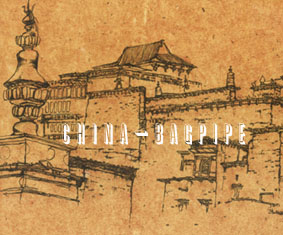|

"With
her unspoilt beauty, Diqing,is an Edenic garden far from the
madding crowd, capable of capturing one at first sight.
Shrouded in mystery from time immemorial, Diqing entrances
one with her spellbinding charms and brings one into a land
of pro-mise, a never-never land full of divine wonders and
rich cultures." This is a true description of the living
SHANGRI-LA of DIQiNG, a Tibetan autonomous prefecture in
Yunnan, China.
Diqing and the Legendary Shangri-la
In his novel Lost Horizon published in 1933, the famous British
writer, James Hilton, describes Shangri-la as a place of
eternity, peace and tranquility, an idyllic world of
imposing snow mountains, deep gorges crystal lakes,
beautiful prairies, green trees, maj estic
but mysterious monasteries. Representing people's longing
for a better life and their strong wish for a utopian
civilized world of peace and happiness, Shangri-la has for
more than 50 years been the dreamland people across the
world seek after. Explorers from all parts of the world
trekked to Tibet, lndia Nepal and other places to find it.
But none of the places they found, to their disappointment,
perectly fit Hilton's description of Shangri-la. Where is
the real Shangri-la? No one could give a definite answer
until the 1990s, when explorers and researchers, after
years' search and investigation, gathered sufficient
evidence to prove that Shangri-la lies in Diqing, Yunnan,
China. estic
but mysterious monasteries. Representing people's longing
for a better life and their strong wish for a utopian
civilized world of peace and happiness, Shangri-la has for
more than 50 years been the dreamland people across the
world seek after. Explorers from all parts of the world
trekked to Tibet, lndia Nepal and other places to find it.
But none of the places they found, to their disappointment,
perectly fit Hilton's description of Shangri-la. Where is
the real Shangri-la? No one could give a definite answer
until the 1990s, when explorers and researchers, after
years' search and investigation, gathered sufficient
evidence to prove that Shangri-la lies in Diqing, Yunnan,
China.
Diqing in Oriental Writers' Works and
Shangri-lain James Hilton's Lost Horizon
Mr. Yang Lizhuo, a senior licentiate of the Imperial College, the
highest educ-ational institute in the Qing Dynasty
(1616-1911), wrote in his Gong Nong Cun Ji, "Far from the
earthly world, Diqing is the paradise of a region, where
people are simple and honest."
In 1933, Ms Liu Manqing, a legendary oriental woman, said in her
Documentary of Zhongdian, "Westward out of Lijiang, the road
became steep rocky trails, as if one were climbing up a
ladder to heaven...Three days later, a vast plain sprang
into our sight, with a refreshing wind singing and a bright
m oon
hanging in the sky. A green expanse of meadow extended as
far as the eye could see. Interspersed among the grass were
yellow flowers and flocks of cattle and sheep. Standing here
and there were some tents. When we came nearer, we saw wisps
of smoke rising from the kitchens of the houses in a
wellarranged town. It seemed as if we had inadvertently come
to a fairyland." oon
hanging in the sky. A green expanse of meadow extended as
far as the eye could see. Interspersed among the grass were
yellow flowers and flocks of cattle and sheep. Standing here
and there were some tents. When we came nearer, we saw wisps
of smoke rising from the kitchens of the houses in a
wellarranged town. It seemed as if we had inadvertently come
to a fairyland."
In his report to the Provincial Government during the Republic of
China (1912-1949), Mr. Zhu Boyong, the then magistrate of
Zhongdian County, wrote, "Although Zhongdian is located in
the frontier area, people here have an honest disposition.
Since all nationalities live in harmony, feuds and
annexations rarely happen among them."
Among the snow mountains in Diqing are vast expanses of grassland.
The fertile verdant meadows there agree with Blue Moon
valley in Lost Horizon. Lying between north latitudes 26052'
and 29o16', Diqing has a temperate and subtemperate mons-oon
climate. But high mountains and deep valleys endow it with a
mixture of distinct vertical climatic patterns, ranging form
tropic to subtropic to glacial. A local saying goes that
"four seasons concur on one mountain and different climates
coexist in an area of ten li". These characteristics are in
accord with those o f
Shangri-la in Lost Horizon. f
Shangri-la in Lost Horizon.
Horse Caravans
as the Link with the
Outside
Before the 1930s, Diqing depended on horse caravans for
communicating with the outside world. The then Diqing was a
forbidding region where there was neither viable water route
nor road to speak of. Like ShangrMa, horse caravans and
porters were the only link of Diqing with the outside world.
|

